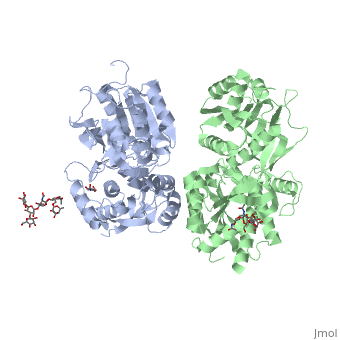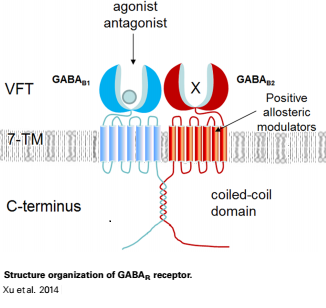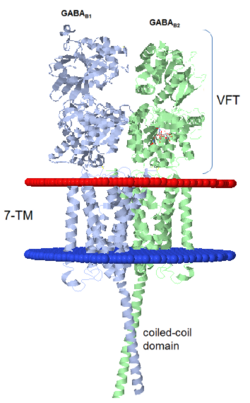User:Rana Saad/The human GABAb receptor
From Proteopedia
Introductionγ-Aminobutyric acid (GABA) is the major inhibitory neurotransmitter in the central nervous system (CNS). It plays a key role in modulating neuronal activity since it binds to specific transmembrane receptors (GABAA,GABAB and GABAC) in the plasma membrane of both pre- and postsynaptic neuronal level. The mammalian GABAB receptor is a class C G-protein coupled receptor[1]. Its structure is similar to the metabotropic glutamate receptors (mGluR) ligand binding domain. The GABAB receptor is central to inhibitory neurotransmission in the brain and so is considered a good candidate for treatments against alcoholism, stress and a number of brain diseases[2]. The GABAB receptor causes the opening of the K+ channels in the postsynaptic membrane, bringing the neuron closer to the equilibrium potential of K+, producing hyperpolarization. As a result, the Ca+2 channels in the presynaptic terminal close, and neurotransmitter release stops. In addition GABAB receptor function lead to reduce the activity of adenylyl cyclase and decrease the cell’s conductance to Ca+2.[1]. StructureGABAB receptor functions as an obligatory heterodimer subunit of GABAB1 (GBR1) and GABAB2 (GBR2). GBR1 (blue) is responsible for ligand-binding (chain A). GBR2 (green), on the other hand, is responsible for G protein coupling subunit (chain B). The GABAB receptor is one of only a few obligate receptor heterodimer currently known. There is no crystal or NMR structure of the complete receptor since it have extracellular and inter cellular regions, Each subunit, GBR1 and GBR2, is a domain of seven-transmembrane helices, composed of a large extracellular domain - venus flytrap (VFT), it is called like this because it is like the venus flytrap while binding agonist and antagonist, and intercellular domain which important for the dimerzation. The extracellular domain VFTThe VFT contains two lobe-shaped domains: LB1 and LB2, which are connected by three short loops. LB1 and LB2 are [3]. Agonist and antagonist bindingAll of the agonists and antagonists bind the extracellular VFT module situated at the crevice between the LB1 and LB2 domains of the GBR1 subunit. Both lobes LB1 and LB2 resdues of GBR1 interact with the GABAB agonsits such as: GABA,baclofen. as a results of this interacting closed conformation will be stabilized when (PDB 4MS3) or (PDB 4MS4) and other agonists. [Image:GABAb_bound_to_agonist.png|center|450px]] GABAB antgonists such as: saclofen, CGP46381, phaclofen, CGP35348 and CGP54626, mostly intercat with LB1 resduses of GBR1. both ends of the antagonist bind the LB1, which produce open confirmation of GBR1. it is very easy to notice the open confirmation when : (PDB 4MQF). (PDB 4MS1). (PDB 4MRM). (PDB 4MR8). (PDB 4MR7). The intercellular dimerization motifWhen the GBR1 subunit is expressed alone, it is trapped in vesicles within the cell, whereas the GBR2 alone is expressed on the cell surface, but cannot bind GABA or activate G proteins. When both receptor subunits are expressed in the same cell, the receptor interact through [4][5] (PDB 4PAS) in their carboxyl tails. They are then expressed on the cell surface, bind GABA and activate G proteins. This domain is shaped by and is stabilized by [6]. Mutagenesis studies of GBR1 and GBR2 in the extracellular domain VFTMutagenesis studies in GBR1 subunit [2] , , : Abolishes signaling via G-proteins and antagonist binding. : Slightly decreases signaling via G-proteins. : Decreases signaling via G-proteins. : Strongly reduces signaling via G-proteins and abolishes antagonist binding. : Strongly reduces signaling via G-proteins, no effect on antagonist binding. Mutagenesis studies in GBR2 subunit [3] : Decreases signaling via G-proteins.
References
| ||||||||||||



